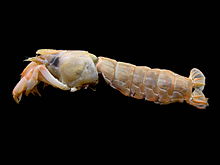
The Caridea, commonly known as caridean shrimp or true shrimp, from the Greek word καρίς, καρίδος, are an infraorder of shrimp within the order Decapoda. This infraorder contains all species of true shrimp. They are found widely around the world in both fresh and salt water. Many other animals with similar names – such as the mud shrimp of Axiidea and the boxer shrimp of Stenopodidea – are not true shrimp, but many have evolved features similar to true shrimp.
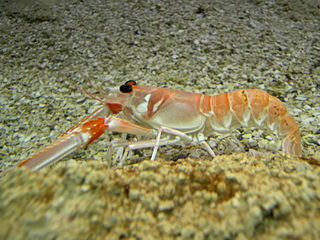
Nephrops norvegicus, known variously as the Norway lobster, Dublin Bay prawn, langoustine or shrimp, is a slim, coral colored lobster that grows up to 25 cm (10 in) long, and is "the most important commercial crustacean in Europe". It is now the only extant species in the genus Nephrops, after several other species were moved to the closely related genus Metanephrops. It lives in the north-eastern Atlantic Ocean, and parts of the Mediterranean Sea, but is absent from the Baltic Sea and Black Sea. Adults emerge from their burrows at night to feed on worms and fish.

Slipper lobsters are a family (Scyllaridae) of about 90 species of achelate crustaceans, in the Decapoda clade Reptantia, found in all warm oceans and seas. They are not true lobsters, but are more closely related to spiny lobsters and furry lobsters. Slipper lobsters are instantly recognisable by their enlarged antennae, which project forward from the head as wide plates. All the species of slipper lobsters are edible, and some, such as the Moreton Bay bug and the Balmain bug are of commercial importance.
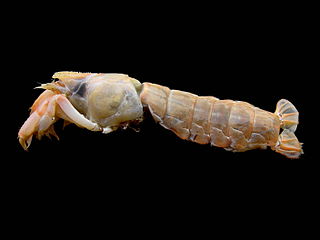
Thalassinidea is a former infraorder of decapod crustaceans that live in burrows in muddy bottoms of the world's oceans. In Australian English, the littoral thalassinidean Trypaea australiensis is referred to as the yabby, frequently used as bait for estuarine fishing; elsewhere, however, they are poorly known, and as such have few vernacular names, "mud lobster" and "ghost shrimp" counting among them. The burrows made by thalassinideans are frequently preserved, and the fossil record of thalassinideans reaches back to the late Jurassic.

Axiidea is an infraorder of decapod crustaceans. They are colloquially known as mud shrimp, ghost shrimp, or burrowing shrimp; however, these decapods are only distantly related to true shrimp. Axiidea and Gebiidea are divergent infraoders of the former infraorder Thalassinidea. These infraorders have converged ecologically and morphologically as burrowing forms. Based on molecular evidence as of 2009, it is now widely believed that these two infraorders represent two distinct lineages separate from one another. Since this is a recent change, much of the literature and research surrounding these infraorders still refers to the Axiidea and Gebiidea in combination as "thalassinidean" for the sake of clarity and reference. This division based on molecular evidence is consistent with the groupings proposed by Robert Gurney in 1938 based on larval developmental stages.

Upogebiidae is a family of mud shrimp crustaceans belonging to the infraorder Gebiidea, within the order Decapoda. They are infauna, living their entire adult lives in seafloor burrows. Over 100 species have been identified, with different species often highly specialized for different types of substrate, even including sea sponges or coral. They are filter feeders, although some species also deposit feed.
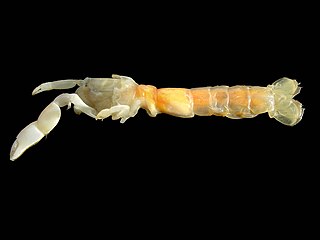
Gilvossius tyrrhenus is a species of mud shrimp which grows to a length of 70 mm (2.8 in). It lives in burrows in shallow sandy parts of the sea-bed in the Mediterranean Sea and northern Atlantic Ocean. It is the most common thalassinidean in the Mediterranean, and has been used as bait by fishermen for at least 200 years.

Squilla mantis is a species of mantis shrimp found in shallow coastal areas of the Mediterranean Sea and the Eastern Atlantic Ocean: it is also known as "pacchero" or "canocchia". Its abundance has led to it being the only commercially fished mantis shrimp in the Mediterranean.

Thalassina is a genus of mud lobsters found in the mangrove swamps of the Indian Ocean and western Pacific Ocean. Its nocturnal burrowing is important for the recycling of nutrients in the mangrove ecosystem, although it is sometimes considered a pest of fish and prawn farms.

Axius serratus is a species of thalassinidean crustacean found off the Atlantic coast of Canada and the United States, from Nova Scotia to Maryland. It is capable of living in areas which are so polluted that other benthic animals cannot survive.

Goneplax rhomboides is a species of crab. It is known by the common name angular crab because of its angular carapace. Although it is also called the square crab, its shell is in fact more trapezoidal than square. This species is also known as the mud-runner because they are able to run away quickly when threatened.
Callianassa subterranea is a species of burrowing ghost shrimp. This species is known by such generic common names as "mud shrimp" and "ghost shrimp".
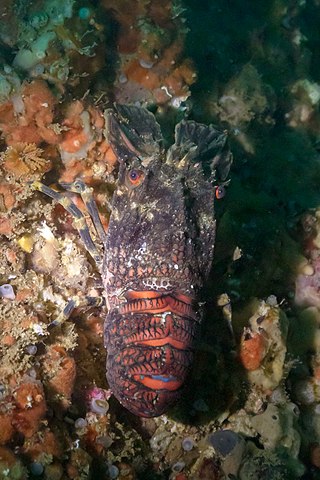
Scyllarus arctus is a species of slipper lobster which lives in the Mediterranean Sea and eastern Atlantic Ocean. It is uncommon in British and Irish waters, but a number of English-language vernacular names have been applied, including small European locust lobster, lesser slipper lobster and broad lobster.

Minuca pugnax, commonly known as the Atlantic marsh fiddler crab, is a species of fiddler crab that lives on north-western shores of the Atlantic Ocean.

Polycheles typhlops is a species of blind, deep water decapod crustacean with a cosmopolitan distribution. It is "one of the dominant and most characteristic crustaceans in deep-sea communities of the Mediterranean Sea".

Neotrypaea californiensis, the Bay ghost shrimp, is a species of ghost shrimp that lives on the Pacific coast of North America. It is a pale animal which grows to a length of 11.5 cm (4.5 in). One claw is bigger than the other, especially in males, and the enlarged claw is thought to have a function in mating. N. californiensis is a deposit feeder that lives in extensive burrow systems, and is responsible for high rates of bioturbation. It adversely affects oyster farms, and its numbers are controlled in some places by the application of pesticides. It carries out an important role in the ecosystem, and is used by fishermen as bait.

Crustaceans may pass through a number of larval and immature stages between hatching from their eggs and reaching their adult form. Each of the stages is separated by a moult, in which the hard exoskeleton is shed to allow the animal to grow. The larvae of crustaceans often bear little resemblance to the adult, and there are still cases where it is not known what larvae will grow into what adults. This is especially true of crustaceans which live as benthic adults, more-so than where the larvae are planktonic, and thereby easily caught.

Lepidophthalmus turneranus, the Cameroon ghost shrimp, is a species of "ghost shrimp" or "mud lobster" that lives off the coast of West Africa. It occasionally erupts into dense swarms, one of which resulted in the naming of the country Cameroon.

Inachus phalangium, Leach's spider crab, is a species of crabs from the north-eastern Atlantic Ocean and Mediterranean Sea. It is up to 20.5 mm (0.81 in) wide, and is very similar to other species in the genus Inachus.

Thalassina anomala, known as the scorpion mud lobster, is a species of crustacean in the family Thalassinidae.
